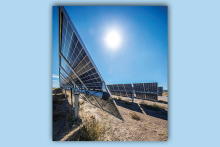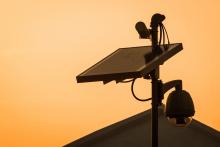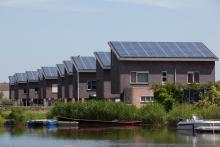solar panels

SINCE I AM a Christian, I worship the Son, not the sun. That said, I’ve been spending most of my time lately thinking about that large ball of gas the good Lord was kind enough to hang in the sky, 93 million miles away. In fact, we’re getting ready for an entire weekend devoted to considering the most important object in our physical world — though it is the only one you can’t look at directly. SunDay will happen on September 20 and 21, 2025 (details at SunDay.earth), and I hope it’s a chance for real reverence.
The sun already supplies light, heat, and photosynthesis, and now it’s ready to provide all the power we could ever need. In the last decade, engineers have dropped the price of solar power by 90%; they have done similar work for batteries that store power for when the sun goes down. We now live on a planet where the cheapest way to generate power is to point a sheet of glass at the sun.
If we take full advantage of those new facts, we stand some chance of limiting the damage from the climate crisis. Last year, California reduced the amount of natural gas it used to generate energy by 25% compared to its usage in 2023. This is the most hopeful statistic I’ve come across in my 35 years of working on global warming. California was able to do this because it had put up enough solar panels to really make a difference. And this could happen everywhere. Texas is currently building clean energy faster than anywhere else in North America but is miles behind China, which put up about 60% of the planet’s solar panels last year.

The majority of the American solar industry has opposed the tariffs, saying that it would be detrimental to the industry. The Solar Energy Industries Association (SEIA) predicted the loss of approximately 23,000 jobs within the sector due to the imposed tariffs in a press release.

FOR SOMETHING as simple as sunlight, the solar energy industry can be a bit complicated. But that never stopped pastor Brian Flory from trying to see the light.
“Putting solar panels on the roof of our congregation was important to us,” said Flory, who runs the Beacon Heights Church of Brethren in Fort Wayne, Ind. “For us it seemed like a wonderful opportunity to live out the values that our faith was leading us toward.”
To live out one of the core values of his faith—being good stewards of God’s creation—Flory began the process of installing panels on his church’s roof in 2014. He’d barely raised the needed $20,000 to support the project when a bill in the Indiana state legislature nearly stopped him in his tracks.

The ink is barely dry on the latest plan to deal with climate change. One can hardly claim that Lima was a resounding success, but it’s not a complete failure either. With 2014 looking to be the hottest year on record, very fast action indeed is needed to keep a global mean temperature below 2 degrees celsius over pre-industrial levels. Given that people are suffering now from less than 1 percent celsius, it is already too late to avoid some consequences of climate change. However, there is still time to avoid the worst of the scenarios, and Lima at least commits all nations to act, even if the harder decisions are to be made in Paris in 2015. Meanwhile, the clock keeps ticking.
In Australia, things have looked pretty grim for those of us concerned about the future. While I’ve been encouraged as I have gone around speaking at churches and Christian organisations, and seen the enthusiasm for something to be done, our reaction in the public sphere has often been muted. There are sections of the church who could be showing much greater moral leadership on this issue. Climate change is an issue for all Australians — indeed for all of humanity, regardless of ethnicity, religion, or politics. The reality of a drying continent, a longer and more volatile fire weather season, and deadlier heatwaves does not discriminate.
Further, with the removal of the carbon tax, an attack on the Renewable Energy Target, and the continued pushing of coal at state and federal level, we seem to be going backwards, not forwards. It is heartening to see an about-face on the Green Climate Fund, but it simply isn’t enough to play Good Samaritan when you are one of the robbers waylaying the innocent.

EARLIER THIS YEAR, 14 solar panels were installed on my roof. Each day since—in fact, multiple times a day—I've eagerly checked our online meters, as the sun replaces coal and nuclear plants as the provider of my home's electrical needs.
I've waited a long time for this. I attended my first energy conference in the late 1970s, when I joined several other students from the hunger action group at our Jesuit college, Seattle U., for the 20-hour van ride to Denver—even then, the connection between poverty and energy issues was clear.
That conference was one of several conducted by the U.S. Catholic bishops to gather input for what became a major and still-relevant document published in 1981 under the unassuming name "Reflections on the Energy Crisis." The statement noted that "solar power can help open the way to permanent energy security, pointing beyond the end of fossil fuels."
So last summer I was thrilled to sign a contract with a company called SolarCity, which installed the solar panels on my rooftop under a lease arrangement—they own the panels, and I buy solar power from them whenever the sun shines. And there's sure a lot of sunshine to tap: Every hour of daylight on earth, the sun releases the amount of energy consumed by the entire population of the planet in one year.
Two Muslim Americans resopnd in different ways to TLC's All-American Muslim; authors honored at 2011 National Books Awards; solar organizations introduce Occupy Rooftops; how cloud seeding effects water shortages and weather systems; Google's new music store; and much more.
In 1979, then-President Jimmy Carter announced the installation of solar panels on the White House roof.